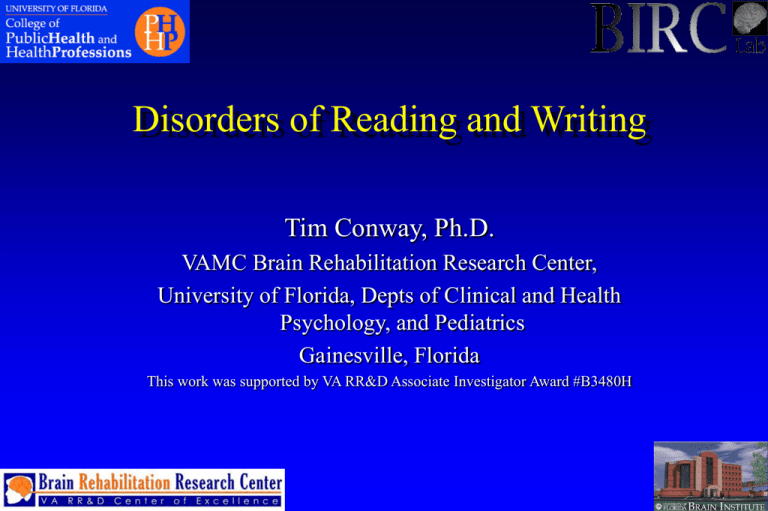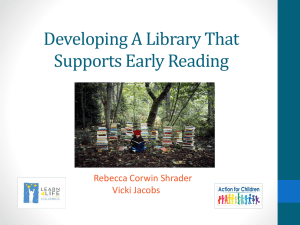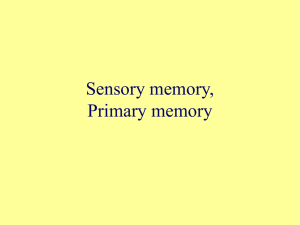Treatment of Acquired and Developmental Alexia
advertisement

Disorders of Reading and Writing Tim Conway, Ph.D. VAMC Brain Rehabilitation Research Center, University of Florida, Depts of Clinical and Health Psychology, and Pediatrics Gainesville, Florida This work was supported by VA RR&D Associate Investigator Award #B3480H Language development What language system develops first, oral or written? What is the purpose of a written language system? What do graphemes represent? Language development (cont) When do we first learn the sounds (phonemes) of English, Spanish, Japanese, French…? What sensory systems aid learning speech sounds? Visual Auditory Tactile kinesthetic and somatosensory Infant studies (see Kuhl, et al., 2006) Language development (cont) What sensory input is consistent in phonemes? Categorical speech perception (Liberman and Mattingly, 1987) The awareness of speech sounds or phonemes in words is called… phonological processing (Wagner and Torgesen, 1987) Language development (cont) Why is the perception of phonemes, phonological processing, important? When does phonological processing begin developing? Does phonological processing occur in speech, reading and spelling? Language development (cont) How does phonological processing aid the development of speech, reading and spelling? e.g. learning to say, read and spell new words. If you have trouble perceiving the phonemes in words (poor phonological processing), how do you know what letters to use for spelling? How would difficulty segmenting a word into its constituent sounds affect spelling, reading, speech? Language development (cont) What determines the shape of a grapheme? What kind of mistakes would someone with poor phonological processing make on language tests? Is the development of speech, reading and spelling an errorful or errorless learning experience? How does phonological processing/awareness aid the development of an ability to perceive errors in speech, reading, and spelling? (DEMO – spell and read) STROSK THROIGE Phonological Awareness “one’s sensitivity to, or explicit awareness of, the phonological structure of the words in one’s language.” (Torgesen, 1994); e.g. the number, identity, and order of phonemes. Comparator Function Holding two words in memory & comparing their sameness or difference in phoneme number, order and identity is called comparator function (Lindamood, Bell, and Lindamood, 1997). Language development (cont) 1. 2. 3. Three things that individuals with well developed reading and spelling skills can do are: Sound out words (a phonological approach) Memorize words (a visual memory approach) Use semantics/meaning (story context) Phonological processing aids an indirect route (grapheme to phoneme conversion or vice versa) to reading and spelling. Basic 2 Route Model of Reading (Coltheart, 1985) PRINT Visual Word Recognition Grapheme-Phoneme Conversion System Semantics Spoken Word Production SPEECH SPEECH Area Spt (left) auditory-motor interface pIFG/dPM (left) articulatory-based speech codes STG (bilateral) acoustic-phonetic speech codes STS phoneme representations Hickok & Poeppel (2000), Trends in Cognitive Sciences Hickok & Poeppel (2004), Cognition pMTG (left) sound-meaning interface Subtypes of Dyslexia and Alexia Dyslexia: (developmental reading disorder) Developmental Phonological (poor at sounding out pseudowords or novel real words) Developmental Surface (not established but believed to exist; poor at reading sight words, good at sounding out words) Alexia: (acquired reading disorder) Phonological (misread pseudowords or novel real words) Surface (misread sight words or words that can not be sounded out, like yacht). Deep (same as phonological but also make semantic paraphasias, says “duck” when reading swan). Pure (Word and nonword reading are very slow, and the patient normally reads by spelling out the word or nonword aloud (naming each letter in left-to-right sequence) - hence the term "letter-by-letter reading”) Subtypes of Agraphia (see Roeltgen’s chapter in Heilman and Valenstein’s, Clinical Neuropsychology, 4th Ed) Agraphia: (acquired spelling disorder; linguistic components) Phonological Surface/Lexical Deep/Semantic Apraxic Pure? What is the purpose of diagnosis? Treatment comes in three forms: Prevention Remediation Rehabilitation Prevention of Developmental Dyslexia Preventing Reading Failure in Young Children with Phonological Processing Disabilities: Group and Individual Responses to Instruction Joseph K. Torgesen Richard K. Wagner Carol Rashotte Elaine Rose Patricia Lindamood Tim Conway Cyndi Garvan (1999). Journal of Educational Psychology 91, 579-593. *NICHD, National Center for Learning Disabilities, Donald D. Hammill Foundation Prevention study - participants 1,436 children in 13 kindergarten classrooms were screened with a serial letter naming test. Bottom 30% received a second screening to estimate IQ and measure phonological skills (elision). 180 children selected with an estimated VIQ > 75 and the lowest combined scores on serial letter naming and phoneme elision (bottom 12%). Random assignment: NTC, RCS, EP, PASP (ie. LiPS program) LiPS: 20 min. x 4 days per week x 2.5 years (88 hours); 50% with untrained aides. Prevention study – LiPS group outcome data 45 Percent retained in K or 1 40 35 30 25 20 15 10 PASP 0 EP 5 RCS end of 2nd grade: 50th percentile in word reading skills (accuracy AND fluency). LiPS - Significantly stronger in phonological awareness, phonemic decoding, & word reading than all other groups. Best predictors of growth in reading: attention/behavior, home background, and P/A. NTC At Remediation of Developmental Dyslexia Intensive Remedial Instruction for Children with Severe Reading Disabilities: Immediate and Longterm Outcomes from Two Instructional Approaches Joseph K. Torgesen Ann W. Alexander Richard K. Wagner Carol Rashotte Kytja Voeller Tim Conway (in press). Journal of Learning Disabilities. Supported by NICHD, NCLD, DDHF Remediation study - participants 60 children, 8-10 yoa, staffed ESE/SLD (exceptional student education or specific learning disability) Teacher referred, VIQ > 75, >=22 SS below average on word identification and word attack, below grade level phonological awareness (LAC test). Randomly assigned to two groups (LiPS and Embedded Phonics [EP]). 1:1, 2-50 min. x 5 days/week x 8 or 9 weeks (67.5 hours); generalization 50 min. x 1 day/week x 8 weeks Follow-up testing over a 2 year time period; n = 26 and 24. ADD/ADHD comorbidity 81% & 71% (LiPS and EP). Remediation - Outcome data Effect sizes of growth in reading skills were 4.4 and 3.9 (LiPS and EP; vs. pre-intervention measures of reading. LiPS - fastest rate of growth in word attack, reading rate and accuracy, and developmental spelling. Significant growth in nonword repetition, rapid naming (digits and letters), and The phonological awareness. intensity and frequency of intervention significantly impacts growth in reading skills. Remediation – LiPS Outcome data (cont) 40% staffed out of ESE within 1 year of intervention;(vs. 5% national norm). Reading comprehension, phonemic decoding accuracy and text reading were Average at 2 yr f/u, and fluent at 4 year f/u. 66% of children demonstrated comprehension of written language >= 1SD above their receptive language abilities. Best predictors of growth in reading skills were attention/behavior (confound), receptive language skills (CELF-III), and prior phonological awareness (an inverse relationship). Alexia Rehabilitation Treatment of a case of phonological alexia with agraphia using the Auditory Discrimination in Depth (ADD) Program Tim Conway Patricia Heilman Leslie Gonzalez-Rothi Ann W. Alexander Stephen Nadeau John Adair Bruce Crosson Kenneth Heilman Journal of the International Neuropsychological Society (1998), 4, 608-620. Alexia Rehabilitation - case study 50 year old male, 14 years education, ambidextrous (left for writing & eating). Sudden onset of aphasia, alexia, agraphia, limb apraxia, and visual field cut. 15 months post onset of CVA (cerebrovascular accident). Resolving conduction aphasia, mild phonological alexia, & mixed dysgraphia. Goal: rehabilitate phonological awareness deficits & improve reading ability. Alexia Rehabilitation Posterior two-thirds of left temporal lobe, portions of inferior parietal and occipital lobes (including AG, SMG, Wernicke’s & Heschyl’s gyri). Alexia Case Study - reading probes Read aloud simple nonword probe 100 80 Read aloud complex nonword probe 60 40 Read aloud multi-syllable nonword probe 20 0 Baseline Post Oral Awareness Post Simple Post Complex Post Multisyllable Spell irregular word probe Alexia Case Study - dependent measures Improved pseudoword reading (73, 93, 90% correct on pre, post, and follow-up testing [Battery of Adult Reading Function, Rothi et al., 1984;]; 99, 112, 115 Standard Score [WRMT-R, 1987]) Improved word identification (99, 103, 113 Standard Score [Wodcock Reading Master Test-Revised WRMT-R, Woodcock, 1987]) Improved auditory working memory & phonological awareness (LAC-MAC 50, 92, 100%; Lindamood Auditory Conceptualization Test-Multisyllable Auditory Conceptualization, Bell & Lindamood, 1996). Self-report of improvement after only 30 hours of treatment. Alexia Rehabilitation (cont) Alterations in the Functional Anatomy of Reading Induced by Rehabilitation of an Alexic Patient. John Adair Stephen Nadeau Tim Conway Leslie Gonzalez-Rothi Patricia Heilman Isaac Green Kenneth Heilman Neuropsychiatry, Neuropsychology, and Behavioral Neurology, 13 (4), 303311. Alexia case study (functional SPECT imaging data on same 50 yo CVA participant) Hypotheses A Significant difference in the pattern of cerebral blood flow will be found between: baseline language task and nonlinguistic task in right hemisphere, baseline language task and post-rehabilitation language task in the right hemisphere, between the 2 language tasks in both ventral frontal convexity regions. Alexia case study - Imaging Tasks Language - silent reading of pseudowords Nonlinguistic Maze task - visual tracing of Porteus Alexia case study – increased Cerebral Blood Flow (CBF) Language 2 > Language 1 (increased activity from post-treatment versus pre-treatment comparison) Right hemisphere: Left Frontal (middle & inferior frontal gyrus; BA 9 & 45) Parietal (angular and supramarginal gyrus; BA 39& 40) Temporal (large contiguous area of modestly increased regional counts - superior, middle, posterior middle and inferior gyrus; BA 21,37, & posterior 22). Hemisphere: large contiguous areas of modest increase Frontal (inferior gyrus & premotor; BA 44 & 6) Parietal Opercular (BA 40) Alexia Conclusions - Participant #1 Effective rehabilitation of mild phonological alexia that appeared to engage right-hemisphere cortex, homologous to left-hemisphere areas usually involved in reading and language. Also, may have re-connected spared Left-hemisphere language structures. Possible aids to treatment outcome: intact Broca’s area, ambidexterity, highly motivated, mild level of impairment, intensity and frequency. Alexia Case study #2 (different CVA participant) Single-subject, multiple-baseline design and pre- post-treatment testing. 92 hours of treatment over a 12-week period, (LiPS ) TM treatment description in Kendall et al, 2003. Alexia Case study #2 right handed, 48-year-old male, 12th grade education, with an ischemic stroke 81 months prior to the current study. T1 weighted MRI showed infarction in left hemisphere operculum and frontoparietal involvement. He demonstrated phonological alexia, agraphia, anomia, and nonfluent aphasia before treatment. Imaging tasks included pseudoword repetition and pseudoword reading, only repetition data is presented here; Behavioral change: improved pseudoword repetition post-treatment pseudoword reading improved over 47 standard scores points from pretreatment to 3 month follow-up Multiple-probes Pseudoword Repetition 100 90 80 % correct 70 Baseline Baseline Phase Phase Treatment Treatment Phase Phase 60 50 40 30 20 10 0 1 2 3 4 5 6 7 8 9 10 11 12 13 14 15 16 17 18 19 20 21 Alexia Case study #2 - Nonword repetition Pre-treatment L Post-treatment R L R Alexia Conclusions – Participant #2 Generalization of a phonological-motor treatment to pseudoword repetition involved increased activity in some left perilesional cortex and the right-hemisphere SMA. Decreased activity in the right hemisphere was evident posttreatment. Increased activity in two perilesional regions, decreased activity in several regions (mostly on right hemisphere) Improved behavioral performance indicates neural reorganization towards increased cortical efficiency following a successful phonological-motor treatment. THANK YOU FOR YOUR ATTENTION AND PARTICIPATION








